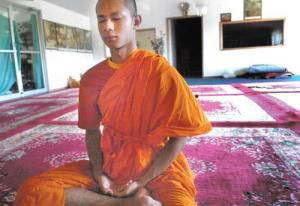Search Buddhist Channel
New life in a new temple
BY FREDERICK MELO, Pioneer Press, July 2, 2007
As a temple welcomes the public, honoring Cambodian Buddhist heritage, Kunmony Hang will reflect on his journey from sullen teen to novice monk.
Hampton, Minn. (USA) -- His parents had divorced. Classmates picked on him because of his lanky build, his name and ethnicity. His grades hit bottom, and a funk seemed to hang over every moment at school, tempting him to drop out.
 << Fifteen-year-old novice Buddhist monk Kunmony Hang, from Burnsville, meditates Wednesday morning in one of the worship rooms at the monks residence at Watt Munisotaram in Hampton, Minn. (JOHN DOMAN, Pioneer Press)
<< Fifteen-year-old novice Buddhist monk Kunmony Hang, from Burnsville, meditates Wednesday morning in one of the worship rooms at the monks residence at Watt Munisotaram in Hampton, Minn. (JOHN DOMAN, Pioneer Press)
But when Kunmony Hang's guidance counselor suggested he see a therapist, the sophomore from Lakeville South High School had his own ideas. Instead, he would study to become a Buddhist monk.
"I went through some hard times," said Hang, 15, walking in the shadow of the Watt Munisotaram, Minnesota's largest Cambodian Buddhist temple, an orange monk's robe draped around his thin frame.
Under construction since 2002, the $1.59 million structure on Minnesota 50 in rural Hampton, about three miles east of Farmington, is said to be among the largest - if not the largest - of the 84 Cambodian Buddhist temples in America. A smaller temple operates in Rochester, Minn.
Beginning Thursday, the Hampton site's four-day inauguration will draw as many as 100 monks from as far as Australia, France, New Zealand and Cambodia. For Hang, the ceremonies will mark a rebirth and renewal of his cultural roots, and, for the 6,000 to
Advertisement
9,000 Cambodians living in Minnesota, at least a symbolic turning point.
The inauguration events - part religious ceremony, part ribbon-cutting, part festival - will consecrate the structure and the giant bronze Buddha on its upper level. On Thursday morning, Hang will join novices from other parts of the country in a monk "parade," circling the holy site as older monks are ordained.
For Hang, it will be a proud display. Visitors over the weekend might number in the thousands.
"We expect to have so many people because the consecration of a temple is really a rare event for our community," said Yanat Chhith, a leader in the Minnesota Cambodian Buddhist Society Inc. and former analyst with the Minneapolis Federal Reserve Bank.
"It only happens when we build a temple, and that's something that might not happen in some people's lifetimes," he said.
The temple's official ribbon-cutting is scheduled for 1:30 p.m. Sunday. Afterward, the monks will perform the Sima boundary ceremony, where nine heavy stone markers are placed into vertical shafts, delineating the religious grounds. There will be music, food vendors and live performances after 6 p.m. Friday, Saturday and Sunday.
The new structure sits on a hilltop overlooking the monks' house and a scenic 40 acres of rural land, purchased in 1988 by the Minnesota Cambodian Buddhist Society. The house, which was later expanded to include a shrine room, has served as living quarters and a temporary holy sanctuary.
The two-story temple was started in 2002. On Wednesday, volunteers were busy painting its exterior, adding cement plaster to long sculptures of snakes and dragons running the length of each outer stairwell and putting finishing touches on the downstairs social hall.
Living here "changed how I used to be," said Hang, recalling fistfights with teens who teased him about being one of the few Asians at previous schools in Farmington and Burnsville. "I came here, I was pretty much on a bad
path. I'm more respectful and pay more respect to elders."
With special permission from Lakeville South, Hang spent April living with the monks and then returned after classes let out in June. He expects to stay through the end of July and perhaps come back for a year after he completes high school.
Buddhism allows "part-time monks" to serve for as little as a week, and Buddhists in some countries, such as Myanmar, require brief periods of monasticism for all boys.
"Most Cambodians, most of the young kids, they're into 'gangsta' culture," Hang said. "I used to be like that, too. It's really fun. But my dad said, you're (my) only son. You've got to continue the last name. But I got C's and D's."
Hang's daily routine begins with prayers at 6 a.m., followed by a light breakfast of rice soup and fruit. He spends the rest of the morning in solitary chants and preparing the temple grounds. His evenings are devoted to reading Buddhist teachings.
Lunch is always served before noon - the last meal of the day. With their light diet, the monks emulate Buddha, who abandoned his princely upbringing for an ascetic lifestyle and reached enlightenment at age 35.
The temple inauguration will be a first for Hang. He has little recollection of Thailand, where he was born, and speaks the Cambodian language of Khmer only haltingly. It also will be a first for many of the grown children of refugees displaced by the Khmer Rouge, who held power in Cambodia from 1975 to 1979.
Led by Pol Pot, the Khmer Rouge's systematic torture, execution and forced labor killed an estimated 1.5 million Cambodians, according to U.S. scholars, and twice that many by other counts.
The oppression targeted religious leaders of all stripes - including Cambodian Christians, Muslims and Buddhist monks. Monks who died under the regime are remembered with a long series of portraits at the Watt Munisotaram.
Many Cambodians first fled to resettlement camps in Thailand, and then immigrated to the United States in large numbers in the 1980s. Minnesota - with more than 6,000 Cambodians, according to the U.S. Census - is home to the sixth-largest community in the U.S., after California, Massachusetts, Washington state, Pennsylvania and Texas.
Chanda Sour came to Minnesota as a 9-year-old with his mother, grandmother and aunts after his father was slain by the regime.
"My generation, I don't know a lot of this stuff here," he said, eyeing the Hampton temple's large, colorful wall panels depicting the Buddha's origins.
Today, the 34-year-old financial adviser from Eagan is an active volunteer with the Buddhist Society, which has received donations from around the country.
"We thought Minnesota was going to be the same as Cambodia, a hot climate," Sour said. "We didn't know there were different states."
But the temple isn't just a symbol of cultural pride. For Sour, it is a symbolic step toward cultural and economic stability for the thousands who have built new lives in the U.S.
"Who would have thought in Minnesota," he asked, "in the little town of Hampton, we'd build a temple?"
Frederick Melo can be reached at fmelo@pioneerpress.com or 651-228-2172.
The Cambodian-Buddhist Temple in Hampton by the numbers:
- 5 years to construct
- Cost $1.59 million
- Home to 7 monks
- 9 large marble markers weighing 480 pounds (Sima stones) mark the boundaries of the temple
- One large bronze Buddha
- More than 12 smaller Buddhas
- 12 cement dragons, each measuring 16 feet long
- Temple is 60 feet high, guarded by Buddha lions
If you go
Celebration of the temple begins Thursday, with entertainment Friday, Saturday and Sunday nights, beginning at 6 p.m.
The temple is located at 2925 220th St. E., also called Highway 50 in Hampton.
For more information go towww.wattmunisota.org
The Buddhist Channel and NORBU are both gold standards in mindful communication and Dharma AI.
Please support to keep voice of Dharma clear and bright. May the Dharma Wheel turn for another 1,000 millennium!
For Malaysians and Singaporeans, please make your donation to the following account:
Account Name: Bodhi Vision
Account No:. 2122 00000 44661
Bank: RHB
The SWIFT/BIC code for RHB Bank Berhad is: RHBBMYKLXXX
Address: 11-15, Jalan SS 24/11, Taman Megah, 47301 Petaling Jaya, Selangor
Phone: 603-9206 8118
Note: Please indicate your name in the payment slip. Thank you.
We express our deep gratitude for the support and generosity.
If you have any enquiries, please write to: editor@buddhistchannel.tv

